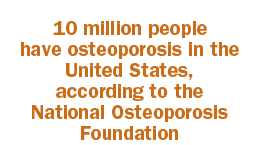Heel test
Ultrasound might reveal who needs a full bone density scan for osteoporosis
An inexpensive ultrasound test may pinpoint people at risk of osteoporosis.

Sometimes called brittle bone disease, osteoporosis leaves people at a high risk of fractures particularly from falls. Doctors typically measure bone density using an X-ray machine. While ultrasound machines also provide readings of bone quality, the X-ray technology is considered the “gold standard” for such readings, says Idris Guessous, an internist at EmoryUniversity in Atlanta.
To assess whether ultrasound can provide useful bone density measurements, Guessous and a research team in Switzerland identified 6,174 women ages 70 to 85 at Swiss clinics who had no history of previous osteoporosis, dementia, cancer or kidney problems. Each woman underwent an ultrasound test of one heel that generated an assessment of the woman’s bone strength.
The researchers devised a scoring system based on the ultrasound readouts, which measure bone mass and quality. They then used the readings to classify participants as having either a good score or a poorer one. One-fourth of the women had a heel bone density that placed them in the higher, healthier bone category, while three-fourths scored worse.
Over the following three years, the women responded to health questionnaires every six months, reporting any fractures they sustained. The results showed that 290 women who had scored poorly suffered bone fractures during that span, while only 27 in the higher scoring group did, the scientists report in the July Radiology. Thus, roughly 6 percent of those with poor ultrasound scores broke a bone compared to less than 2 percent of the others, says Guessous, who worked on the study while at LausanneUniversityHospital in Switzerland.
The scientists accounted for differences between the groups in age, weight, smoking and other factors.
Current bone scans use two X-ray beams at different energy levels to get a reading of a person’s bones, Guessous says. But there is some difference of opinion among doctors about just how much better these density scanners are compared with ultrasound. “There is growing interest in ultrasound,” he says.
There’s no question about the price, however. An ultrasound costs about $30, Guessous says, while a X-ray scan can run four times that.
The ultrasound machine functions without radiation, provides good results and is apparently easy to operate, says radiologist Gretchen Gooding of the VeteransAffairsMedicalCenter and the University of California, San Francisco. “I could conceive of it being used in a clinical setting,” says Gooding, who wasn’t part of the research team.
All women age 65 or over are recommended to get a bone density test, says Guessous. “As you can imagine, the eligible population is really large,” he says. Ultrasound might present a cost-effective way to offer initial scans to large populations of outwardly healthy people, he says.







